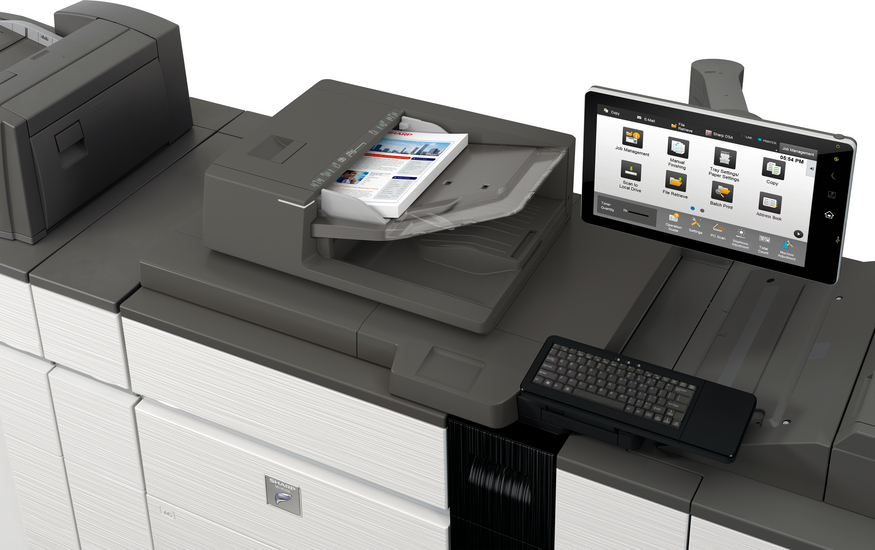It’s a viable alternative for dealers who aren’t ready to leap into production print.
You’d think there would be a definition of light production, but there isn’t. Some vendors dodge the question by citing the jobs that fall into this category, but that’s like saying a horse is an animal.
For some, light production is more volume on a printer used by many people. Others say it’s dozens of pages that must be printed and bound on one device. Some insist it is a steady stream of jobs that intermix color and monochrome pages. Still others describe it as long runs of a single document. You probably have your own definition. So do your customers. Everyone is correct. And some never think about it at all, sending jobs beyond a certain size to a local printer.
“The definition of light production is not what it was ten years ago,” said Andre D’Urbano, vice president of sales at RISO. “The definition changes with market dynamics.”
Technology also changes the definitions, enabling a broader range of jobs on a single device. “Applications are becoming more complex,” added William Donnelley, senior campaign and strategy manager, Ricoh graphic communications, dealer channel at Ricoh USA.
Generally, though, light production is defined by the volume, environment, and capability of the equipment. Volume ranges from 25,000 to 50,000 per month, although volumes upwards of 100,000 aren’t uncommon.
Kent Villarreal, senior product manager, product planning and marketing, Sharp Electronics Corp. U.S.A., noted, “Light production printers are designed for printing, copying, and scanning. They can be placed in shared environments because operators don’t need to be high-volume experts.” This sounds like a big MFP shared by several people—not unlike offices of 30 or so years ago—when one would go to a company’s copy center to get multiple copies of anything.
Can Less Be More?
Less than ten years ago, vendors were rolling out inkjet printers bigger than crew cab long-bed pickup trucks that sprayed ink onto hundreds of pages per minute and wore seven-digit price tags. Commercial printers were a prime market while most office technology dealers’ customers managed with less capable machines. Now they want more color and speed. Finishing, beyond a basic corner staple, also is expected. Vendors are filling this gap, but designing, testing, and bringing new machines to market is far from simple.
Meanwhile, customers wanting to cut print costs find their options limited to reducing the number or size of MFPs in use, limiting the amount of printing done, mandating duplex printing, and restricting the use of color. So, they turn to their dealer for expertise. When running the numbers, some customers may benefit from having one or two light production machines accessible to many workers. The customer knows some employees will complain about being unable to print at their desks, but lowering costs is more attractive.
The shift to only printing pages when necessary has appeal because print has a permanence that screens lack. Multi-page reports still need to land on the desks of 36 people, some of whom don’t like reading off a screen. The deck of 23 color slides has to be viewed by multiple eyes, and other documents have to pass muster with legal, which insists on printed pages. Light production can help many organizations control print costs while providing more opportunities for office technology dealers.
In-plants = A Big Target
In-plants frequently are responsible for the copiers, scanners, and MFPs throughout a company. This can help place some light production machines in appropriate places, such as shared hallway copiers. Office technology dealers are well-positioned to take advantage of changing office dynamics.
“They can place light production machines in the in-plant operations of school districts; higher education; municipal, state and county operations; healthcare, and non-profit organizations,” affirmed RISO’s D’Urbano.
“It’s a matter of doing more with less,” added John Fulena, vice president of production and industrial printing, dealer division, Konica Minolta Business Solutions, U.S.A. “We’re seeing machines with more capabilities going into in-plants simply because of labor and automation.”
What’s being printed has changed, too. “End customers are looking for coated and textured media on both lightweight and heavier media,” said Ricoh’s Donnelly. “In-line finishing and professional booklets are also important, especially in in-plants. What’s more, variable data is becoming expected.” Gen-X and Gen-Y workers get this—and there are a lot of them in the workforce.
Another driver of in-plants is the increase in remote/hybrid work environments. Web submission allows customers to reduce the number of desktop and convenience devices needed. Furthermore, depending on how electronic job submission is configured, employees may be able to submit print jobs to an in-plant or shared device remotely and have them printed and ready for pickup or distribution.
Inkjet or Toner?
Toner-based printers usually are better for jobs requiring higher quality and a wide variety of media. Inkjet tends to have lower operating costs, making it well-suited for higher volume jobs. Both will continue overlapping as technology evolves, and a trickle-down effect from high-end inkjet machines is likely.
On the toner side, Donnelley noted that Ricoh’s Pro C5300 and Pro C5310 devices (that operate at two user-selectable speeds) can be a good fit for in-plants or agencies needing light production printers. “It’s typically multiple users or a department that needs color-critical work in a tight print window rather than steady volumes,” he explained.
Sharp’s BP-90C70 and BP-90C70 toner presses are another player. These devices offer edge-to-edge printing, which can add a more professional look to a document without trimming. Then there’s Konica Minolta’s AccurioPress C4065, AccurioPress C4070, and AccurioPress C4080. These fit the light production space, and some can be configured with finishing options for creating business cards, flyers, brochures, direct mail, and booklets.
On the inkjet side, RISO has rolled out the Valezus T2200, a compact machine that can print duplex cut-sheet pages up to 330 pages a minute. Such speed, on the lower edge of some high-ticket production presses, can be a good fit for in-plants needing to produce many pages but lacking the space, budget, or consistent volume needed to justify a production-class machine. An upside for this compact production machine (about 17 feet long) is that it requires only a 240-volt current, an easily addressed wiring upgrade in most businesses.
Service Is Critical
“If you can’t afford a proven [servicing] structure, you should probably not enter the market,” said Ricoh’s Donnelley. Harsh words and more than a cautionary note.
Light production printers are not merely amped-up versions of desktop MFPs. These are highly capable machines with more demanding service requirements. Most are cut-sheet, and some can accept page sizes up to 13 x 19-inches. This drives the need to expand paper supplies, but the internal parts—rollers, drums, gears, print heads, and the like—cost more and may require more space. This may give the machine a larger footprint than many office printers while making service needs more demanding and more frequent. Customers should be aware of these differences so they aren’t surprised by more costly service contracts.
Additionally, don’t let the higher duty cycle of some light production machines lure your tech team into complacency. It may mean they have to be more proactive about service. Look at this as an opportunity to be more visible and attentive to customer needs.
Light production also means accommodating a customer’s workflow. “You must have trained technicians who can diagnose and service machines based on the customer’s production schedules,” advised Fulena. This requires knowing more about customers so that techs don’t show up 15 minutes into a customer’s 2-hour print run.
Equally important, there’s more to service than timing. “I’d caution against making my best break-fix technician the lead service person and analyst who troubleshoots a Fiery or color management issue,” suggested Donnelly.
It’s better to have a different tech specifically trained on the issues of light production devices. These machines frequently require specialized training beginning with the software that drives the device and extending to all the moving parts. Techs not familiar with the ins and outs of Fiery workflows and PDFs, for example, will need to get up to speed. This helps build a stronger and deeper bench by emphasizing the strengths of your team.
Go for It
The market will not come to you. You must go after it. Be proactive. Invite people to lunch-and-learn sessions to educate them on the benefits of the in-plant and shared printers you can offer.
Next, talk with customers and learn the details of their print volumes, turnaround times, finishing requirements, and more. “Dealers with annual revenues from $2 million to $500 million should offer light production,” said D’Urbano. Although there won’t be a fit for every customer or dealer, plenty of potential business exists. Make a point of understanding customers’ needs and how you can offer cost-effective solutions that can drive their—and your—business forward.



